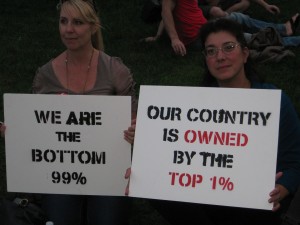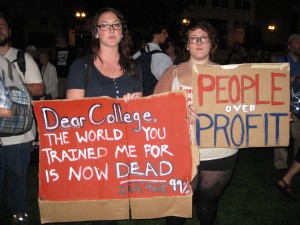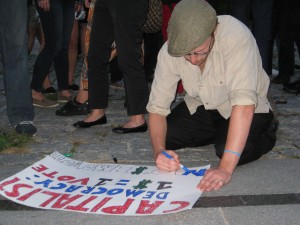Occupy Boston Protest Begins to Solidify into an Organized Movement
Posted by Noelle Swan With shoulder length hair tucked under a trucker’s cap, the young doe-eyed man looked more like Keith Stone, the fictional character in Keystone beer’s commercials, than a protest organizer. However, in the last week, Garrett, who wishes not to disclose his name, has become a principle organizer of a movement that hopes to ignite a nationwide discussion of economic class.
With shoulder length hair tucked under a trucker’s cap, the young doe-eyed man looked more like Keith Stone, the fictional character in Keystone beer’s commercials, than a protest organizer. However, in the last week, Garrett, who wishes not to disclose his name, has become a principle organizer of a movement that hopes to ignite a nationwide discussion of economic class.
The Occupy Boston movement first took form a week ago as several Boston residents returned from a trip to New York City to support protesters that have occupied Zuccotti Park near Wall Street for two weeks now. Much like their Occupy Wall Street counterpart, organizers used Twitter and other social media websites to call Bostonians to action. Organizers estimate that 300 people met last Tuesday, Wednesday, and Thursday to plan the occupation of Dewey Square in downtown Boston.
On Friday night, at the start of the group’s occupation at the foot of the Federal Reserve and in the shadow of the Fiduciary Trust Building, Garrett was surrounded by a tightly knit huddle of eager demonstrators ready to participate in the formation of a strategic plan of action for nearly one thousand protesters occupying the park. Many brought tents, tarps, and sleeping bags and plan to occupy the park indefinitely.
”We operate by democratic consensus here in our new society,” Garrett prefaced before requesting strategic proposals to bring to the larger group later that evening. After hearing from a few participants, Garrett turned to the oldest participant before him, a gentleman with a scraggly gray beard and an arm draped around his young daughter’s shoulders, and asked him to share his wisdom.
Listening appeared to a highly prized value among the participants.
Many protesters wore bandanas tied over their mouths in symbolic representation of a voiceless 99 percent.
“The top 1% of earners hold 50% of America’s wealth,” shouts a young organizer, dressed in a white button down shirt and skinny black tie who introduced himself to the crowd simply as Nadeem. The crowd repeats his every word in unison in a system borrowed from the Wall Street protesters and dubbed “the people’s mic” which ensures all voices can be heard. “Many of them use that wealth to undermine democratic process,” he continued. “I am here ‘cause this can change everything.” The crowd roared with approval.
At some point during the assembly meeting on Friday, an audience member informed the crowd that there were deaf individuals in attendance. Immediately someone hopped up along side the organizers to interpret into American Sign Language.
 While the protest has gotten the attention of the press and even Bank of America, which sent sandwiches and potato chips to Dewey Square, it’s still not clear what the group expects to accomplish with this protest.
While the protest has gotten the attention of the press and even Bank of America, which sent sandwiches and potato chips to Dewey Square, it’s still not clear what the group expects to accomplish with this protest.
Individual participants have vastly different agendas. Supporters of Lyndon LaRouche pushed their pet project to enact the Glass-Steagall Act, a Depression-era banking reform law that was repealed in 1999 and which proponents say would make large corporate bailouts by the federal government illegal.
Upon hearing mention of LaRouche, the perennial presidential candidate and political theorist, one protester tore his bandana off his mouth and blurted out, “Larouche is here? I ****ing hate Larouche.”
At a table near the entrance to the train station, one group distributed information about Marxism. At another table lay a variety of books on socialism, and communism.
However, the majority of participants did not appear to be calling for total revolution.
“I don’t think people go to rallies and marches and think that anything will immediately change,” said Zach Milligan, an unemployed resident of Cambridge who came ready to camp out with a couple of college buddies, a tent, and photocopies of recommendations from the American Civil Liberties Union on how to interact with the police.
Milligan said he came in hopes of sparking “a realistic shifting of priorities.” He added that he doesn’t care for the socialist agenda and expressed concern that the presence of socialist advocates divert the attention from realistic discussion.
The majority of participants, like Milligan, did not appear to be calling for complete change in political culture. Instead, they were frustrated, angry, and seeking an outlet where they could be heard.
In an effort to create a clear message, the activists have formed an outreach committee to come up with a list of specific demands. One idea being considered is a call for the resignation of the presidents of the four largest U.S. banks, including Bank of America, bringer of sandwiches.
Another committee focused on organizing efforts to disseminate information to the public through the media, citizen journalists, and social media websites.
While many participants appeared to be college students and recent graduates, the atmosphere was serious. One middle-aged protester commented to her companion, “I keep half expecting to see glow sticks come out and this turn into rave. But it doesn’t.”
A lone hula-hooper danced in her own world, but no crowd formed around her. A young man played his guitar for an audience of one. Overall, participants came prepared to work.
Related posts:
- Wall Street Protests Come to Boston Common
- RI bus riders protest proposed service cuts
- Copley Square Flash Mob Promotes Boston’s Marketing Industry {Video}
- Mitt Romney To Speak In NH On Sunday; Tea Party Organizes Protest Using Social Media
- Still No Power Because Of Irene? Check Out Where You Can Go In The Boston Area To Snag Some Free Wi-Fi
Short URL: http://www.newenglandpost.com/?p=4808








